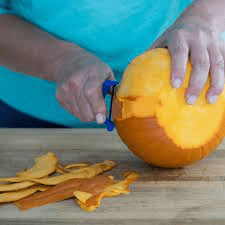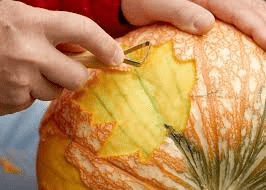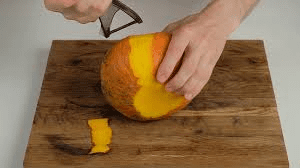The pumpkin rind also referred to as the skin or peel, encompasses the outer layer of the pumpkin fruit and is typically thick and tough in texture. While often discarded during cooking or carving, the pumpkin rind is surprisingly rich in nutrients and offers several potential uses that contribute to both culinary creativity and health-conscious practices.
Nutritionally, the pumpkin rind contains a variety of vitamins, minerals, and antioxidants that can benefit overall health. It is particularly rich in dietary fiber, which is essential for digestive health. Fiber helps regulate bowel movements, promotes a feeling of fullness, and supports a healthy gut microbiome. Including pumpkin rind in recipes can boost fiber intake and enhance the nutritional profile of dishes.
Vitamins found in the pumpkin rind include vitamin A (as beta-carotene), vitamin C, and vitamin E. These vitamins play crucial roles in immune function, skin health, and vision. Beta-carotene, in particular, gives the pumpkin rind its characteristic orange color and is important for maintaining healthy eyesight and supporting immune function.
Minerals such as potassium, magnesium, and zinc are also present in the pumpkin rind. Potassium helps regulate blood pressure and supports proper muscle function. Magnesium is involved in over 300 biochemical reactions in the body, including energy production and nerve function. Zinc contributes to immune health, wound healing, and DNA synthesis. Including pumpkin rind in recipes can provide a natural source of these essential nutrients.
In culinary applications, the pumpkin rind can be used in various creative ways. When cooking with pumpkins, leaving the rind intact and incorporating it into recipes can add texture and flavor. Roasting or baking pumpkin with the rind on can create a tender and flavorful dish. The rind can also be chopped or diced and added to soups, stews, and curries, where it will soften and blend with other ingredients.
Another approach is pickling or preserving pumpkin rind. Pickled pumpkin rind is a traditional dish in some cultures, where the rind is boiled or blanched, then marinated in vinegar, spices, and sugar. Pickled pumpkin rind can be served as a side dish or used as a condiment to complement savory dishes.
For those looking to reduce waste and maximize the nutritional benefits of pumpkins, using the rind in cooking is a sustainable practice. The rind can be cooked and blended into purees or sauces, adding depth and nutrition to dishes. It can also be dehydrated and ground into a powder, which can be used as a natural thickener or flavor enhancer in recipes.
From a culinary perspective, exploring the versatility of pumpkin rind opens up new possibilities for creating delicious and nutritious meals. Whether roasted, pickled, or incorporated into soups and sauces, pumpkin rind offers a unique way to enhance dishes with its rich flavor and nutritional benefits.
In conclusion, the pumpkin rind is a valuable part of the pumpkin fruit that shouldn’t be overlooked. Its high fiber content, vitamins, minerals, and antioxidants make it a nutritious addition to a balanced diet. By exploring different cooking methods and recipes, we can harness the potential of pumpkin rind to create flavorful dishes while promoting health and sustainability.
The Economic Importance and Uses of Pumpkin Rind

1. Culinary Ingredient: Pumpkin rind can be used in various culinary applications, adding flavor and texture to dishes. For example, it is used in pickling recipes.
2. Animal Feed: Leftover pumpkin rind from processing can be used as animal feed, providing fiber and nutrients for livestock.
3. Composting: Pumpkin rind is biodegradable and can be composted to enrich soil quality, supporting sustainable agriculture practices.
4. Art and Crafts: The tough texture of pumpkin rind makes it suitable for crafting and artistic projects, such as making decorative items and ornaments.
5. Decorative Uses: Pumpkin rind can be used decoratively in seasonal displays, enhancing fall-themed decorations and centerpieces.
6. Herbal Remedies: In some traditional practices, pumpkin rind is used for its medicinal properties, believed to aid in digestive health and detoxification.
7. Environmental Sustainability: Utilizing pumpkin rind reduces food waste and promotes eco-friendly practices in food production.
8. Educational Purposes: Pumpkin rind is used in educational settings to demonstrate composting and sustainability concepts to students.
9. Seasonal Products: During autumn, pumpkin rind can be incorporated into seasonal products like crafts, decorations, and natural dyes.
10. Cultural Significance: In some cultures, pumpkin rind is used symbolically or ceremonially, reflecting cultural traditions and values.
11. Fiber Source: Pumpkin rind is rich in dietary fiber, which supports digestive health and can be beneficial in dietary supplements.
12. Soil Amendment: Composted pumpkin rind can improve soil structure and fertility, enhancing crop yields and plant growth.
13. Pest Control: Some agricultural practices use pumpkin rind extracts as natural repellents for pests and insects.
14. Ethical Consumerism: Consumers interested in sustainable practices may choose products that utilize pumpkin rind, supporting ethical food production.
15. Biodegradable Packaging: Innovations in sustainable packaging may utilize biodegradable materials like pumpkin rind, reducing environmental impact.
16. Community Engagement: In community gardens and urban agriculture projects, pumpkin rind can be used to educate and engage community members in sustainable practices.
17. Culinary Innovation: Creative chefs experiment with pumpkin rind in gourmet dishes, exploring new flavors and textures in culinary arts.
18. Nutrient Recycling: Recycling nutrients from pumpkin rind through composting contributes to closing nutrient loops in agricultural systems.
Read Also: Long Haired Cat Breeds Description and Complete Care Guide
The Products and By-products That Can Be Derived From Pumpkin Rind

1. Pickled Pumpkin Rind: Pumpkin rind pickled in vinegar and spices, used as a tangy condiment or snack.
2. Compost: Decomposed pumpkin rind used to enrich soil fertility and structure in gardens and agricultural fields.
3. Decorative Ornaments: Dried and decorated pumpkin rind used in crafts and seasonal decorations.
4. Natural Dyes: Extracts from pumpkin rind used to create natural dyes for fabrics and artistic purposes.
5. Educational Tools: Pumpkin rind used in educational settings to demonstrate composting and environmental concepts.
6. Pest Repellent: Extracts from pumpkin rind used in organic pest control solutions for gardens and farms.
7. Biodegradable Containers: Innovations in sustainable packaging may utilize pumpkin rind as a biodegradable material for containers.
8. Fiber Supplement: Ground pumpkin rind used in dietary supplements for its high fiber content and digestive benefits.
9. Artistic Medium: Dried pumpkin rind used as a medium for artistic creations and sculptures.
10. Seasonal Crafts: Pumpkin rind used in seasonal crafts, such as Halloween decorations and fall-themed art projects.
11. Soil Enhancer: Composted pumpkin rind improves soil health and fertility, supporting sustainable agriculture practices.
12. Traditional Medicine: In some cultures, pumpkin rind is used in traditional medicine for its purported health benefits.
13. Ethical Products: Products made from pumpkin rind appeal to consumers interested in ethical and sustainable food choices.
14. Community Gardens: Pumpkin rind used in community gardens to enrich compost and educate participants about sustainability.
15. Culinary Experimentation: Creative chefs use pumpkin rind in innovative dishes, exploring its culinary potential.
Read Also: Complete List of Different Types of Cat Breeds
Frequently Asked Questions (FAQ’s) About Pumpkin Rind

1. Can you eat pumpkin rind?
While technically edible, pumpkin rind is tough and usually not consumed due to its texture. It is more commonly used in pickling or discarded.
2. How do you pickle pumpkin rind?
To pickle pumpkin rind, peel and cut it into strips or cubes, then boil in a vinegar solution with spices until tender. Store in sterilized jars.
3. What nutrients are in pumpkin rind?
Pumpkin rind contains dietary fiber, vitamins, and minerals, although the concentration varies compared to the flesh and seeds.
4. Is pumpkin rind good for composting?
Yes, pumpkin rind is excellent for composting due to its biodegradability and nutrient content, which enriches the soil.
5. How do you dry pumpkin rind for crafts?
To dry pumpkin rind for crafts, slice it thinly and either air-dry or use a dehydrator until fully dried. Decorate as desired for artistic projects.
6. Can pumpkin rind be used as a natural dye?
Yes, extracts from pumpkin rind can be used to create natural dyes for fabrics and artistic purposes, producing earthy tones.
7. What are the benefits of using pumpkin rind in crafts?
Using pumpkin rind in crafts promotes sustainability by repurposing waste material and creating unique, biodegradable artworks.
8. How long does pumpkin rind take to decompose in compost?
Pumpkin rind can take several weeks to months to fully decompose in a compost pile, depending on environmental conditions and compost management.
9. Can pumpkin rind be used in organic gardening?
Yes, composted pumpkin rind enriches soil health in organic gardening by providing nutrients and improving soil structure.
10. Is pumpkin rind safe for pets?
Raw pumpkin rind is not recommended for pets due to its tough texture and potential digestive issues. However, cooked or processed pumpkin rind may be safe in moderation.
Read Also: Design criteria for comminutor and Grinder

